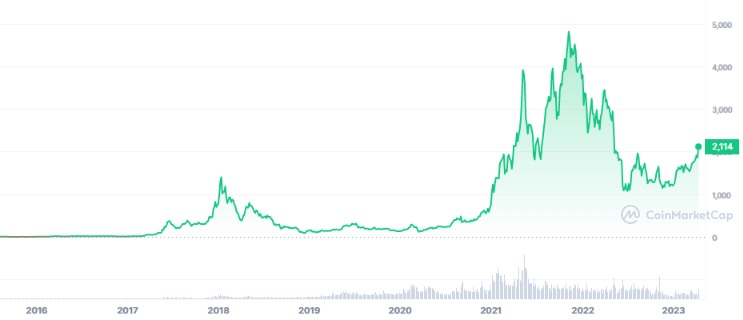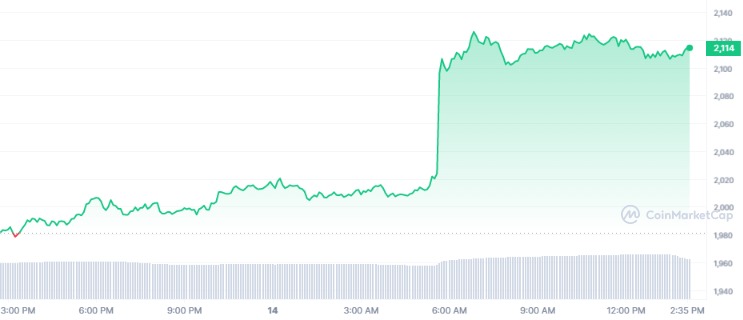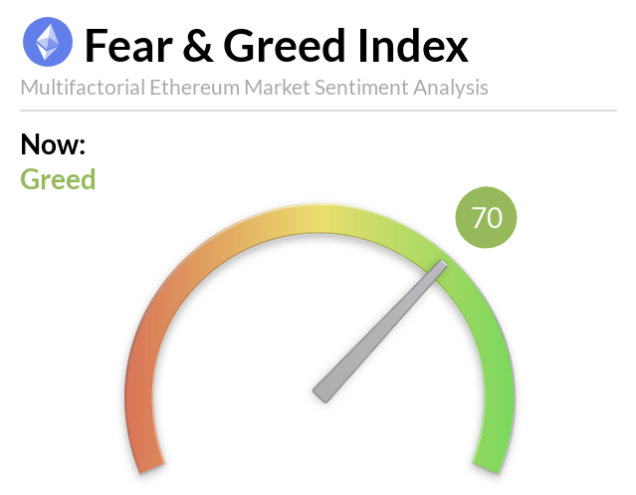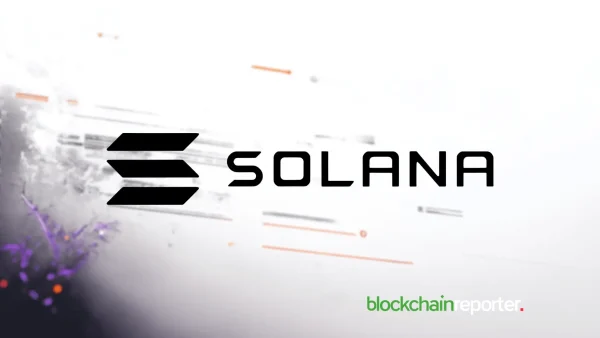
- 1. Ethereum: An Introduction
- 2. Ethereum (ETH) Price Statistics
- 3. Comparison between Ethereum and Bitcoin
- 4. Ethereum (ETH) Price Prediction: Price History
- 5. Ethereum (ETH) Price Prediction: Price Analysis
- 6. Ethereum (ETH) Price Prediction
- 7. Can Ethereum (ETH) Reach $100,000
- 8. Conclusion
- 9. FAQ
- 9.0.1. What is Ethereum?
- 9.0.2. Who created Ethereum?
- 9.0.3. What is a smart contract?
- 9.0.4. What is Ethereum's consensus mechanism?
- 9.0.5. What was the Ethereum hard fork?
- 9.0.6. How does Ethereum differ from Bitcoin?
- 9.0.7. What are some Ethereum price predictions for 2023, 2025, and 2030?
- 9.0.8. Can Ethereum (ETH) reach $100,000?
- Ethereum: An Introduction
- Ethereum (ETH) Price Statistics
- A Brief History
- Proof-of-Stake Mechanism
- Grand Split in Ethereum
- Comparison between Ethereum and Bitcoin
- Ethereum (ETH) Price Prediction: Price History
- Ethereum (ETH) Price Prediction: Price Analysis
- Ethereum (ETH) Price Prediction
- Ethereum (ETH) Price Prediction 2023
- Ethereum (ETH) Price Prediction 2025
- Ethereum (ETH Price Prediction 2030
- Can Ethereum (ETH) Reach $100,000
- Conclusion
- FAQ
Cryptocurrency and blockchain technology have long been evolving with the inclusion of exclusive and groundbreaking innovations. This evolution started right due to the shortcomings and difficulties faced by the crypto users who utilized the primary crypto token *BTC*. The initial altcoin (the term used for cryptocurrencies other than Bitcoin) to deal with the issues of the chief crypto was *ETH*. It was developed and launched by Ethereum a few years after.
Ethereum: An Introduction
Fundamentally, Ethereum is known as a worldwide decentralized software platform that uses blockchain technology. It is usually famous for its local crypto token Ether (ETH). The platform of Ethereum can be utilized to develop any safe digital technology. Its token is structured for payment dealing with the work carried out to support the blockchain. Nonetheless, the members can additionally utilize it for the payment of tangible services and goods if accepted. Ethereum is developed to be decentralized, secure, programmable, and scalable.
One important aspect of Ethereum and other cryptocurrencies is the concept of a trading pair. With Ethereum, the most common trading pair is ETH USDT or Ether traded against the Tether stablecoin (pegged to the US dollar).
It is known as a blockchain platform that is preferred by enterprises and developers who are engaged in developing technology to facilitate the industries as well as serve real-world use cases. Ethereum is locally compatible with smart contracts that are categorized as an essential instrument at the back of the decentralized applications (dApps). Several applications related to decentralized finance (DeFi) utilize smart contracts in addition to blockchain technology.
Ethereum (ETH) Price Statistics
| Ethereum (ETH) Price: | $2,009.15 |
| Ethereum (ETH) Rank: | 2 |
| Ethereum (ETH) Market Cap: | $242,018,190,647 |
| Ethereum (ETH) Trading Volume: | $12,792,581,321 |
| Ethereum (ETH) 24h High: | $2,022.15 |
| Ethereum (ETH) 24h Low: | $1,901.86 |
A Brief History
The idea of developing *ETH* is credited to Vitalik Buterin. A white paper was published by him about Ethereum back in the year 2014. The platform of Ethereum was introduced a year later by Joe Lubin (the person who founded the blockchain software firm ConsenSys) and Vitalik Buterin in 2015. The Ethereum founders are considered among the earliest to be in knowledge of blockchain technology’s complete potential beyond just offering a secure method for virtual payments.
Since Ethereum’s launch, a great rise has been witnessed in Ether’s market. As a result of this, the ETH token remained successful in getting the 2nd spot after the top crypto Bitcoin in terms of market value. In this way, it is now the top crypto token among the altcoins. Similar to the rest of the digital assets, Ethereum has blockchain technology underlying it. A blockchain contains blocks in a lengthy chain.
The information kept in each of the blocks is incorporated into each of the latest-developed blocks with exclusive data. Within the network, the blockchain’s identical copy is distributed. A network containing automated programs is responsible for the validation of this blockchain. The respective programs get to a consensus over the legitimacy of the transfer of information. No modifications can be done to the blockchain if the network does not reach a consensus.
The respective characteristic makes it considerably shielded. An algorithm, usually known as a consensus mechanism, is utilized to reach a consensus. Ethereum network utilizes the proof-of-stake algorithm that enables a group of members known as validators to develop exclusive blocks as well as operate in mutual harmony. In this way, they validate the information contained by them.
The blocks keep information dealing with the blockchain’s status, a series of attestations (taking into account a validator’s signature), transfers, and so on. It is noteworthy here that Ethereum formally altered its algorithm from the proof of work (PoW) to proof of stake (PoS) back in September last year with its enormous “The Merge” upgrade. PoW is the power-intensive and expensive consensus mechanism while PoS is the latest, cost-effective, less energy-consuming, and environment-friendly consensus mechanism. The upgraded Ethereum is called Ethereum 2.0.
Proof-of-Stake Mechanism
Proof-of-stake is different from proof-of-work because it does not need the energy-consuming computing known as mining for the validation of the blocks. On the contrary, it utilizes a finalization protocol named Casper-FFG as well as an algorithm named LMD. These are added into a consensus named Gasper. The respective mechanism is responsible for monitoring the consensus as well as defining how validators are given rewards for their work or get punished for their dishonesty.
Single validators are required to stake thirty-two ETH tokens to be eligible for validation. People can stake minor *ETH* amounts, nevertheless, there is a need for them to join a validation pool as well as share the rewards. A validator develops an exclusive block as well as confirms that the information is valid in a procedure known as attestation.
In this process, the block is broadcasted to the rest of the validators within a committee specified for the verification as well as vote for the validity. On the other hand, the dishonest validators – who attempt to assault the network – are penalized as the ETH tokens staked by them are burned. Burning is considered the delivery of crypto assets to a wallet with no keys.
Grand Split in Ethereum
The split or hard fork of Ethereum is known as a prominent incident in the platform’s history, dividing it into Ethereum Classic and Ethereum. Back in 2016, several network members obtained majority control of the platform’s blockchain. As a consequence of that, they took away ETH assets of above $50M worth. The respective funds were specified for a project named “The DAO.” Keeping this in view, the majority of the community demanded the return of the stolen assets.
They wanted this to be done by the invalidation of the present Ethereum blockchain as well as authorizing a blockchain platform with a reviewed history. Nevertheless, a portion of the community intended to keep up with the Ethereum blockchain’s original version. That is how Ethereum’s unmodified version became Ethereum Classic (ETC) following the split. Ethereum Classic’s blockchain still uses the PoW consensus algorithm and several speculations are also being made about the Ethereum mining profitability.
Comparison between Ethereum and Bitcoin
A comparison is often drawn between Ethereum and Bitcoin. Though both crypto tokens have several similarities, there are also a few distinctions among them. The developers and founders of Ethereum describe it as the top programmable blockchain of the world as it is an electronic as well as programmable network that supports several applications. On the other hand, the blockchain of Bitcoin has been developed just to support the *BTC* token.

The cumulative number of Bitcoin tokens to be entered into circulation is up to 21M. As opposed to this, the number of ETH tokens to be created is unlimited, though the time consumed in processing an ETH block limits the number of tokens to be minted every year. The Ethereum tokens in circulation are above 122M. Another important distinction between them is related to how these networks deal with the transfer processing charges.
The respective fees are paid on Ethereum by members while carrying out transfers. The charges linked to Bitcoin transfers are engrossed by the wider Bitcoin network. Above all, the consensus mechanisms of both networks are different although formerly both were using the same. Ethereum is now using a proof-of-stake consensus mechanism while *BTC* is still utilizing its original proof-of-work consensus where the miners need to compete with each other for rewards.
Ethereum (ETH) Price Prediction: Price History
With the past price performance of the crypto assets, the long-term crypto market outlook is clarified. It makes it easy to know more about Bitcoin as well as the altcoin market trends. In the case of Ethereum, the initial transaction on the network was performed back in the year 2015. Since its launch, during the major portion of that year, Ethereum remained under the $1 mark.
Nonetheless, in the next year, Ether moved beyond $10 in terms of price when it reached $10.03 for a brief time on the 4th of March in 2016. In the year 2017, Ether gained considerable fame and touched $100 in May. After that, by the year’s end, the crypto token’s value reached $774.69. Then, within 2018’s 1st week, it even reached above the $1000 spot. Following the unprecedented upsurge, the crypto crash (better called the Bitcoin crash) was also experienced by Ether in 2018.

As a result, a decrease of nearly $100 in price per token was seen by 2018’s end. Following that, between 2019 and 2021, the token again rallied and touched its all-time high price on the 9th of November at approximately $4,815. During 2022’s initial half, the value of the token went through a significant dip. However, several developments have been carried out by the network. The chief characteristics of Ethereum like providing worldwide compatibility for DApps, smart contracts, and other scaling solutions have increased crypto adoption.
Ethereum (ETH) Price Prediction: Price Analysis
At present, the price of Ethereum is $2,009.15. The fundamental analysis of Ethereum’s price says that it has a 24-hour high of up to $2.022.15 while $1,901.86 is its 24-hour low price level. The current price of the token has increased by 4.94% in the recent 24 hours. The market capitalization of Ethereum stands at $242,018,109,647. The 24-hour trading volume of the crypto token is approximately $12,792,581,321. The circulating supply of Ethereum is almost 120,457,776 ETH tokens while its cumulative supply is nearly 120,457,776.

The technical analysis of Ether points out that it has an overall bullish sentiment. This has become possible after the Ethereum network’s continuous efforts to exit the bearish momentum that it was experiencing during the previous months. The potential cause behind it was the general crypto downfall and other macroeconomic factors. Since the initial coin offering of Ethereum, the price of ETH has jumped by up to 6,788.06 times in comparison with the US dollar.
On the other hand, a 105.78 times spike has been seen by the token in comparison with the top crypto Bitcoin. The fear and greed index is placed at 70 showing “Greed.” Apart from that, in the recent thirty days, the token has seen positive price movement in up to 16 days. The token is currently trading at a top point within its trading cycle. Moreover, Ether has a very low inflation rate. The annual inflation rate of Ethereum is almost 0.07% at the moment.

Ethereum (ETH) Price Prediction
The crypto market trends and the market analysis point out that Ethereum will likely see a great upsurge in its value in the coming time irrespective of the cryptocurrency price volatility. Apart from the retail adoption, the institutional adoption of Ethereum is also expected to have substantial uptake in the future. According to the anticipation, the political factors and the global economic factors will also get gradually favourable for crypto. Furthermore, the regulatory landscape around crypto will also be improved to a great extent.
Ethereum (ETH) Price Prediction 2023
The crypto market analysis brings to the front that blockchain technology trends are getting more and more traction around the world. In this respect, Ethereum network scalability will play a significant role in onboarding a lot of exclusive people into the crypto ecosystem. Exclusive innovations like smart contracts in Ethereum are expected to elevate its popularity. Hence, the maximum price of Ether will be up to $2,650 this year. $1,450 will be its minimum price. The crypto token will trade for around $2,050 on average.
Ethereum (ETH) Price Prediction 2025
Ethereum price forecast indicates that the political and economic factors affecting crypto prices will expectedly become supportive for crypto. With the dependence of decentralized finance (DeFi) on Ethereum along with the positive crypto market predictions and trends, *ETH* is expected to reach the price level of $6,000 at maximum by 2025. The minimum price of the token will be nearly $4,300. On the other hand, ETH is anticipated to trade at around $5,150 by that year.
Ethereum (ETH Price Prediction 2030
The positive long-term crypto market outlook suggests that the crypto regulatory landscape and its impact on prices will become positive by the year 2030. Furthermore, the crypto market sentiment analysis signifies that a huge proportion of the financial community will be pro-crypto by that time. Apart from that, the institutional adoption of cryptocurrencies will also have an enormous spike.
In this regard, the Ethereum 2.0 features and benefits will grasp the attention of entrepreneurs. Ethereum price history and trends are presently pointing toward a bullish price momentum to be seen in the next years. It is expected that cryptocurrency investment opportunities will also increase with time.
Particularly, Ethereum adoption and use cases will additionally surge significantly. Therefore, it is projected that the token might reach $15,555 as its maximum price by 2030. The minimum price level of Ether is predicted to be $12,500. Nevertheless, $14,028 will be the average price level of ETH by that year.
Can Ethereum (ETH) Reach $100,000
At present no sufficient data is available on whether Ethereum will touch $100,000. However, Ether’s price can reach the price level of $40,000 by the year 2040.
Fundamentally, Ethereum is known as a worldwide decentralized software platform that uses blockchain technology. It is usually famous for its local crypto token Ether (ETH). The platform of Ethereum can be utilized to develop any safe digital technology. Its token is structured for payment dealing with the work carried out to support the blockchain. Nonetheless, the members can additionally utilize it for the payment of tangible services and goods if accepted. Nowadays there are many ways to earn free Ethereum. Ethereum is developed to be decentralized, secure, programmable, and scalable.
Conclusion
The huge potential of Ethereum discloses that the *ETH* token will offer great investment opportunities. However, investors should also be cautious of the volatility of the crypto market. They should do proper research and keep an eye on good and suitable cryptocurrency trading strategies and investment strategies. Additionally, they should not neglect the risk factor of this space and should only move forward if they have a taste for it.
FAQ
What is Ethereum?
Ethereum is a global, decentralized software platform that uses blockchain technology. It is best known for its native cryptocurrency token, Ether (ETH). The Ethereum platform can be used to develop secure digital technologies, and its token is designed for payment processing for work done to support the blockchain.
Who created Ethereum?
Ethereum was created by Vitalik Buterin, who published a white paper about it in 2014. The platform was launched in 2015 by Buterin and Joe Lubin, founder of the blockchain software firm ConsenSys.
What is a smart contract?
Smart contracts are self-executing contracts with the terms of the agreement directly written into code. They run on blockchain technology and facilitate decentralized applications (dApps).
What is Ethereum’s consensus mechanism?
Ethereum currently uses a proof-of-stake (PoS) consensus mechanism, which allows a group of validators to create new blocks and verify the information within them. Ethereum transitioned from a proof-of-work (PoW) to a PoS mechanism with its “The Merge” upgrade in September last year.
What was the Ethereum hard fork?
The Ethereum hard fork occurred in 2016, when a portion of the community decided to invalidate the existing Ethereum blockchain and adopt a new one with a revised history. This event led to the creation of Ethereum Classic (ETC), which maintains the original, unmodified version of the blockchain.
How does Ethereum differ from Bitcoin?
Ethereum and Bitcoin differ in their purpose, token supply, and consensus mechanisms. Ethereum is designed as a programmable blockchain, whereas Bitcoin’s blockchain is designed solely to support the BTC token. Ethereum has an unlimited token supply, while Bitcoin has a fixed supply of 21 million tokens. Ethereum uses a proof-of-stake consensus mechanism, while Bitcoin still uses proof-of-work.
What are some Ethereum price predictions for 2023, 2025, and 2030?
Ethereum price predictions include:
- 2023: Maximum price of $2,650, minimum price of $1,450, and an average price of $2,050.
- 2025: Maximum price of $6,000, minimum price of $4,300, and an average price of $5,150.
- 2030: Maximum price of $15,555, minimum price of $12,500, and an average price of $14,028.
Can Ethereum (ETH) reach $100,000?
Currently, there is not enough data to determine if Ethereum will reach $100,000. However, it is predicted that Ethereum’s price could reach $40,000 by the year 2040.
READ MORE:
Ethereum Price Prediction: Important Factors For Investors
Baby Doge Coin (BABYDOGE) Price Prediction
Lucid Stock Price Prediction 2025: Can LCID Stock Recover Amid Bearish Sentiment?
EverGrow Coin Price Prediction: Will EGC Skyrocket to $1 Soon?
MANA Price Prediction $100 In 2022-2030: Will Decentraland Rise to $100?
Rivian Stock Price Prediction 2025 & 2030: What Lies Ahead for RIVN Stock Price?











